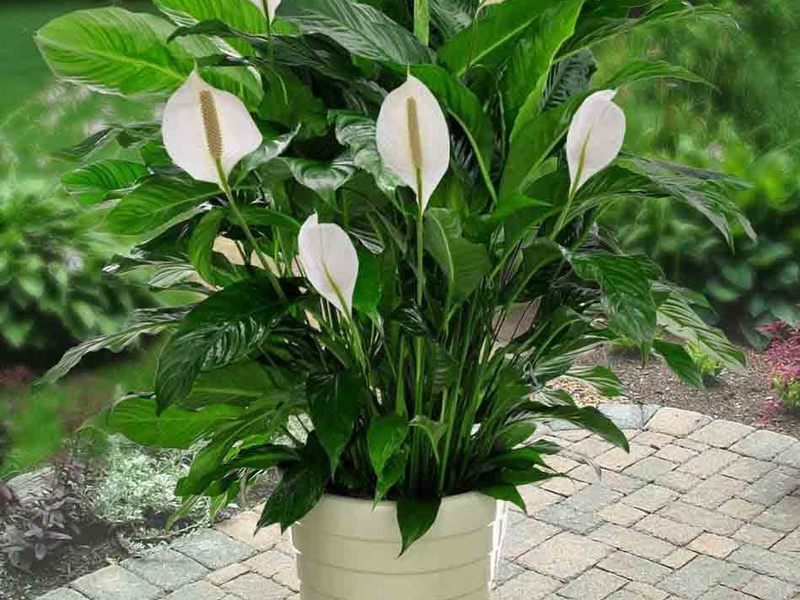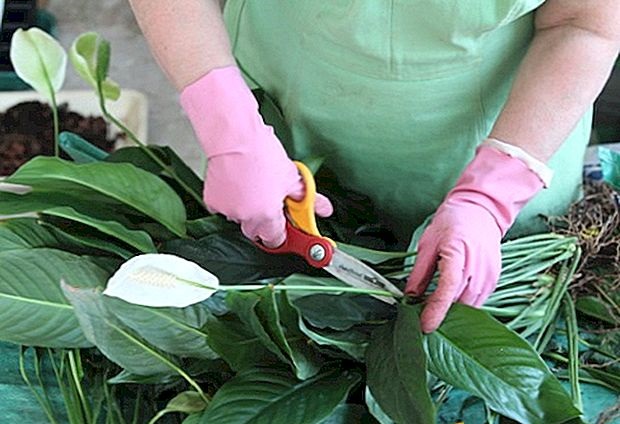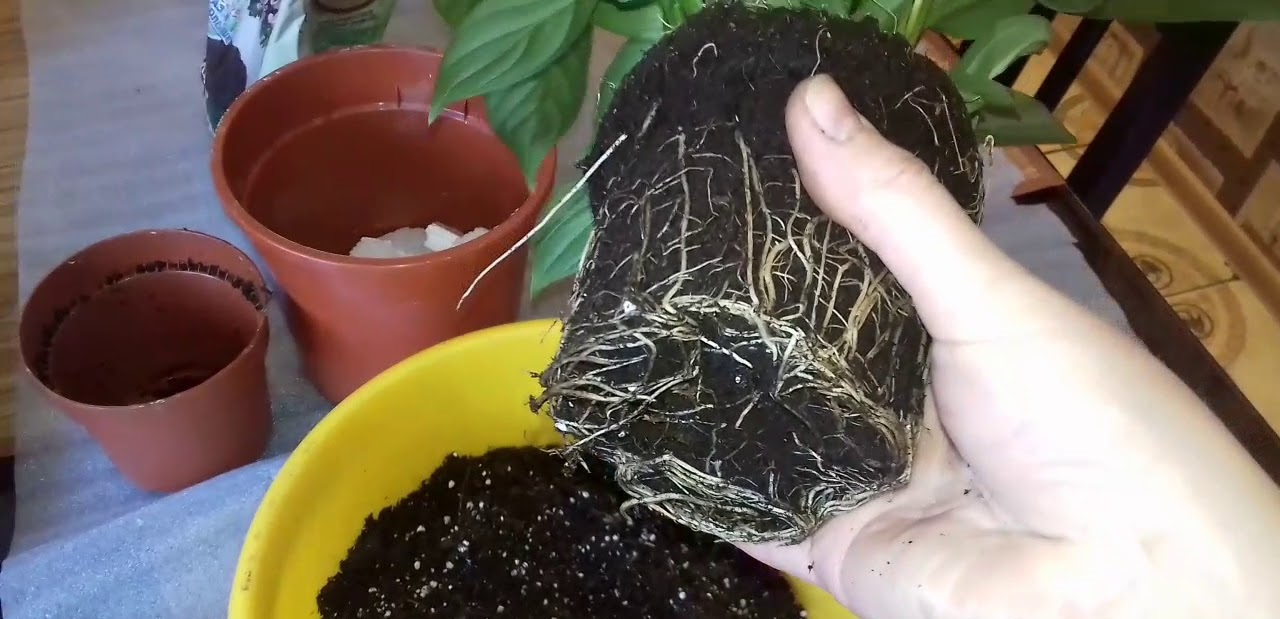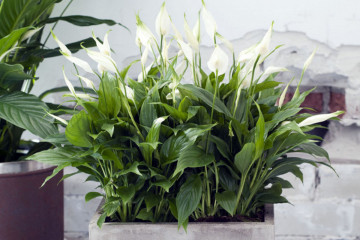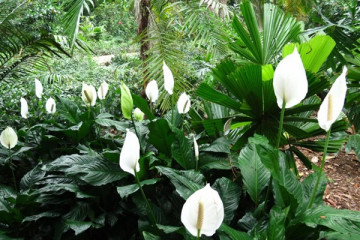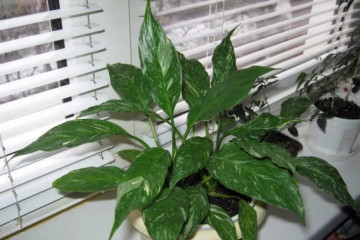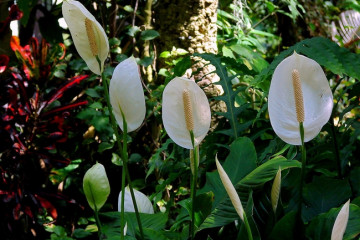Spathiphyllum - flower transplant at home
Content:
The popularity of spathiphyllum is due not only to the exquisite pattern of the bush. There is a popular belief that the presence of a plant in the house brings love with it. In the process of cultivation, the question arises of how to transplant the flower "female happiness" in order to ensure its intensive development.
Description of the plant spathiphyllum
The bush has no stems, small leaves grow directly from the roots, forming dense green bunches. The roots are rather short. Small tubercles are visible on the stem rudiment. These are aerial roots characteristic of plants of the Aroid family. The leaf blade is oval-elongated, pointed, with a noticeable midrib.
The lateral veins are also clearly visible. Small flowers form a white ear on a long peduncle, around which, on one side, a white oval veil with a pointed tip. The name spathiphyllum reflects the specific appearance of the flower: in Greek, "spata" means a veil, and "phillum" means a leaf.
The graceful bloom of spathiphyllum lasts for several weeks, from mid-spring to July. Some varieties bloom from late March to early fall. With good care, the plant forms flowers also in the fall.
If spathiphyllum does not bloom for a long time, a transplant carried out in accordance with the correct recommendations activates the vitality of the plant. In the popular indoor culture, the dormant period begins in October and lasts until January. At this time, provide a temperature of at least 16 ° C and infrequent watering. At high air humidity, flower stalks are created in winter.
For the successful development of spathiphyllum, it is necessary to comply with the following requirements:
- constant high air humidity;
- moderate watering so that the substrate is constantly slightly moist;
- abundant spraying, since the plant comes from tropical forests;
- location in an area of diffused light or artificial lighting, but not in direct sunlight;
- preferable northern exposure or placement on attached platforms near windows;
- comfortable temperature within 20-23 ° С.
Why there is a need to transplant spathiphyllum
The plant grows well if there is sufficient space for the roots. A spathiphyllum transplant at home is carried out in such cases:
- the bush has just been bought and is in a small pot;
- regularly every 3-5 years in the spring to ensure development, since the bush grows quickly, and the roots intertwine, twine around the entire substrate, stick out to the surface;
- if the lower leaves inside the bush dry up;
- for reproduction, choosing from the bundle a fragment where there is a growth point and roots.
There is another important reason when you need to think about how to transplant spathiphyllum faster: in the absence of flowering.
Transplant guide after purchase
The plant from the store is transplanted after 15-25 days. The waiting time before replanting spathiphyllum serves to adapt it to new conditions in a residential building. For a bush, temperature and light conditions change dramatically.Immediate planting in a new substrate will be an unnecessary stress factor. Overgrown bushes are usually moved by transshipment without breaking the old earthen lump.
Step-by-step actions when you need to plant a recently purchased and already acclimatized plant:
- before transplanting, spathiphyllum in a container is watered abundantly;
- when the water is absorbed, the plant is carefully removed, the roots are examined and the used drainage is selected;
- put the plant in a new pot on the laid drainage and a small layer of soil, if necessary, the protruding processes are straightened and sprinkled with soil;
- the upper layer of the substrate is compacted and watered;
- if the substrate settles after watering, add prepared soil.
Features of transplanting flowering spathiphyllum
It happens that suddenly there is a problem of how to plant spathiphyllum in bloom. The plant will endure summer movement without traumatic consequences. Adhere to the following rules:
- the substrate is watered abundantly, then after 30-40 minutes it is removed from the container;
- if the transplant is carried out due to signs of a disease, they examine the roots and cut off the rotten ones with a sharp disinfected knife, and also shorten too long ones;
- the peduncles are cut off with a pruner at the base so that the plant directs energy only for adaptation in a new substrate;
- remove yellowed, wilted leaves and those that have just begun to form;
- the updated bush is placed in a pot, the substrate is poured and compacted.
You can plant a large developed spathiphyllum bush as a whole, it is better to divide it into several parts with healthy rhizomes. If transshipment is carried out, without much intervention in the root system, several young flowers are left, the old ones are removed.
Creating comfortable conditions for spathiphyllum after transplantation, they take care of sufficient humidity. For the first 10-13 days, a frame is installed above the bush, and a plastic wrap is placed on top. The shelter will protect the plant from rapid evaporation of moisture.
During this period, the substrate is watered after the top layer becomes dry. The leaves are sprayed once a day. In the event that the leaf blades droop, spraying is increased, up to 2-3 times a day.
Selection rules
When planting a large spathiphyllum bush or transferring a purchased plant into a new container, pay attention to the choice of a pot and soil recommended for indoor culture.
Pot
When choosing which pot is needed for spathiphyllum, the size of the previous one is determined. The plant is planted in a container, which exceeds the former container by 1.5-2 cm in width and height. Florists noticed that spathiphyllum blooms profusely when the roots cover the entire substrate.
In a pot that is too spacious, the bush will build up the root system and only then discard the peduncles. Containers with holes in the bottom are suitable, through which excess water flows into the pan after watering. As with any indoor plant, a drainage of 1-2 cm is required for spathiphyllum.
Soil
Spathiphyllum develops well in a weakly acidic substrate, pH 5-6.5, loose and light in structure. In such potting mixes, excess moisture seeps into the sump. In the trade network, they choose a universal mixture for aroid or tropical flowering plants, which is mixed with a handful of sand. Many growers prepare the substrate on their own. You can choose a suitable one, usually the simplest in execution, from several options:
- 3 parts of peat, 2 parts of leafy soil, 1 part each of humus, sand and bone meal;
- 1 part of leafy soil, peat, humus, sand, 2 parts of sod land;
- 1 part of leafy soil and peat, half of soddy soil and sand.
Horse peat is used. Wood bark, coconut fiber, charcoal and brick chips are also added to the substrate for looseness.Additives make up no more than 10% of the total mass. They also put sphagnum moss, which protects the soil mixture from drying out.
When transplanting, fertilizer is added - 0.5 teaspoon of superphosphate. If the substrate is prepared independently, the earth is spilled with a dark pink hot solution of potassium permanganate.
Fertilizers
For good flowering, spathiphyllum is regularly maintained with top dressing, otherwise a beautiful green bush will grow, but without the original white covers with flower cobs. Or the stalks will be thrown out for a short time and at long intervals. It is especially important to feed the plant in the spring-summer period, when all processes are activated: once every 10-16 days.
In winter, when the dormant period begins in the room culture, the substrate is fertilized once every 30 days. Spathiphyllum responds well to organic fertilizers available in stores, especially poultry droppings. Any universal preparations for flowering indoor plants are also suitable: "Flower", "Azalea" and others.
If no fertilization was applied at the end of February or in March, the spathiphyllum ends blooming in June, and the flower stalks do not form again. At the same time, too many nitrogen preparations should not be given, since the green mass will grow, but not the buds.
Housewives often water the "woman's happiness" with chilled liquid after boiling pasta or potatoes, used from the aquarium with water. In late autumn and winter periods, when the intensity of natural lighting decreases, the humic fertilizer "Universal plant balm" is used for spathiphyllum. The drug stimulates culture and helps to cope with the lack of light.
How to choose the right time for a transplant
The best time for a planned spathiphyllum transplant is spring. Changing the soil mixture will give the plant new nutrients, the roots will quickly gain their mass, and buds will begin to form. Overgrown bushes are also planted during this period.
The green islet of spathiphyllum with graceful leaves and white bracts needs replanting from time to time. Replacing the substrate and feeding have a beneficial effect on the development of the indoor plant and stimulate a new wave of flowering.
